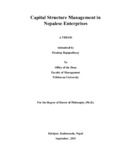Please use this identifier to cite or link to this item:
http://archive.nnl.gov.np:8080/handle/123456789/159| Title: | Capital Structure Management in Nepalese Enterprises |
| Authors: | Rajopadhyay, Pradeep |
| Keywords: | Capital Structure Management |
| Issue Date: | 25-Mar-2019 |
| Abstract: | The capital structure decision is concerned with explaining how the mix of various sources of capital, basically, debt and equity in a firm’s capital structure affects its value. The proposition made by Modigliani and Miller (1958) posits that the firm’s value is independent of its capital structure under the very restrictive assumption of perfect capital market. They claim that the firm’s value depends upon the profitability of its assets and not on the way in which such assets are financed. Subsequent works have relaxed several of the restrictive assumptions behind the irrelevant proposition of Modigliani and Miller and have introduced capital market imperfections into the model, such as bankruptcy costs, corporate taxes, asymmetric information, and free cash flows. Since the firms are allowed to deduct interest paid on debt from their tax liability, firms balance the tax benefits of debt against the cost of financial distress and bankruptcy (Kraus and Litzenberger, 1973). In fact, debt increases the risk of financial distress, potentially avoiding a firm’s excessive debt financing. The higher a firm’s debt ratio, the higher will be the associated probability of bankruptcy. |
| URI: | http://103.69.125.248:8080/xmlui/handle/123456789/159 |
| Appears in Collections: | 300 Social sciences |
Files in This Item:
| File | Description | Size | Format | |
|---|---|---|---|---|
| Final Ph.D Thesis.pdf | 1.86 MB | Adobe PDF |  View/Open |
Items in DSpace are protected by copyright, with all rights reserved, unless otherwise indicated.